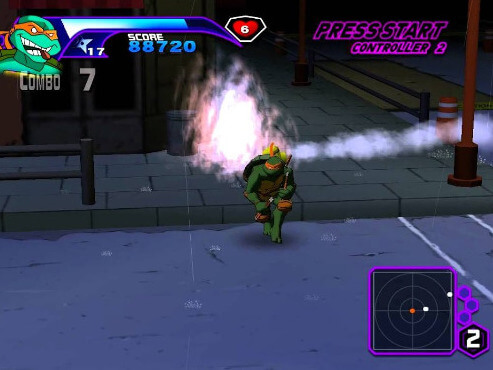

By the end of 1990, the game had sold more than 4 million cartridges worldwide, earning $125 million ( $273 million adjusted for inflation) for Konami. By May 1990, it had sold over 1 million cartridges in the United States.

#TEENAGE MUTANT NINJA TURTLES PC GAME 2004 SERIES#
The NES version of the game will be rereleased as part of Teenage Mutant Ninja Turtles: The Cowabunga Collection for Nintendo Switch, PlayStation 4, PlayStation 5, Xbox One, Xbox Series X/S, and PC in 2022. Due to licensing issues, it was later removed from the Wii Shop Channel in Japan on Januand in North America and Europe on January 26, 2012. It was the first licensed game to appear on the North American and European Virtual Console. In North America, it was released for Wii on Apfor the price of 600 points-100 points more than the average NES game-due to a licensing issue. It was released for the Wii in Europe and Australia for 500 points which was later raised to 600 Wii Points. It was released in 2007 on the Wii's Virtual Console. The initial releases of the DOS and Amiga versions contain programming error that creates a gap that is impossible to cross without cheating or a patch. The game was the UK's number 1 selling Spectrum game for 6 months between March and August 1991. The game was ported to various home computer platforms in 1990, including DOS, Commodore 64, ZX Spectrum, Atari ST and Amiga. The game was released as Teenage Mutant Hero Turtles in all European territories, in line with the renaming of the first cartoon series in those territories. While graphics and gameplay are virtually identical to its NES counterpart, the Japanese localization changed the plot a bit by turning April O'Neil from an acquaintance of the Turtles into Splinter's daughter. Subsequent TMNT video games released in Japan kept the franchise's original title. This was the first TMNT product released in the country, predating the Japanese dub of both the first film and the animated series. The game was released for the Family Computer (Famicom) in Japan a few months earlier than the American NES version under the title Geki Kame Ninja Den ( Japanese: 激亀忍者伝, which loosely translates to "Legend of the Radical Ninja Turtles"). In this level, the Turtles must navigate a number of traps, with a time limit of two minutes and twenty seconds to find and disarm eight time bombs. In the second half of Stage 2, the Turtles dive into the Hudson River (using an underwater version of the side-scrolling gameplay). The player encounters enemy characters, acquires weapons and special items, and collects pizza to restore health. However, in most levels the goal is to reach the exit and return to the overhead map in a previously inaccessible location. In some levels, there is a specific objective (obtaining an item, defeating a boss, etc.).

The primary weapon can be "aimed" upwards or downwards. The special weapons are obtained in limited quantities, although the boomerangs can be reused if the player catches them on the return. These items are occasionally dropped by enemies. These special weapons include single shurikens (throwing stars), triple shurikens (launches three stars simultaneously in a spreading pattern), boomerangs, and the "Kiai", a scroll that expands into a crescent-shaped beam and inflicts devastating damage on even boss characters. In the side-scrolling levels, the Turtles can jump or crouch and attack either with their primary weapons (while jumping, walking, or crouching), or use one of the alternate weapons that they have picked up along the way. As the game progresses, more and more obstacles and enemies appear in the overhead maps. In the overhead view, the player can move in the four cardinal directions and use their primary weapon in a single type of attack. The player navigates the mission map in an overhead view as they travel to doors, manholes or other entrances to the side-scrolling interior levels, which represent the primary gameplay. There are a total of six stages in the game. There is an opportunity to rescue a captured Turtle once in each stage beginning in Stage 3. The player loses the game when all four Turtles have been captured. When the player's current character runs out of health, falls into a fatal trap, or is run over by a Roller Car, he is captured by the enemy, forcing the player to change to one of the remaining Turtles. Each turtle's unique primary weapon has different speed, power and reach. The information screen shows each Turtle's health, whatever special weapon he has obtained, a map grid of the current area, and messages from either Splinter or April.

The player starts the game as Leonardo, but can switch to any of the other Turtles at any time by pressing the Start button to access the information screen. Teenage Mutant Ninja Turtles is a single-player action game. Leonardo surrounded by Mousers in the sewer


 0 kommentar(er)
0 kommentar(er)
